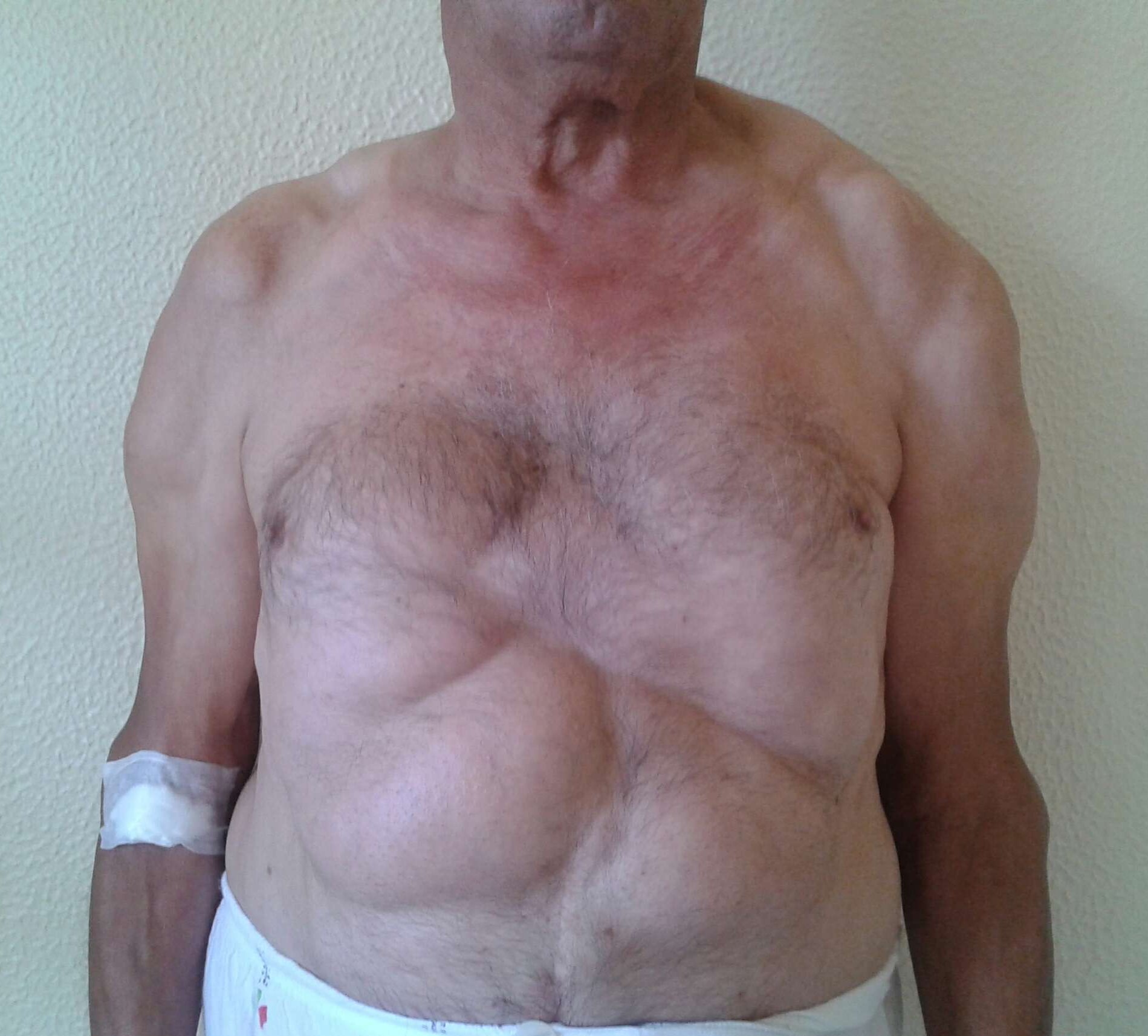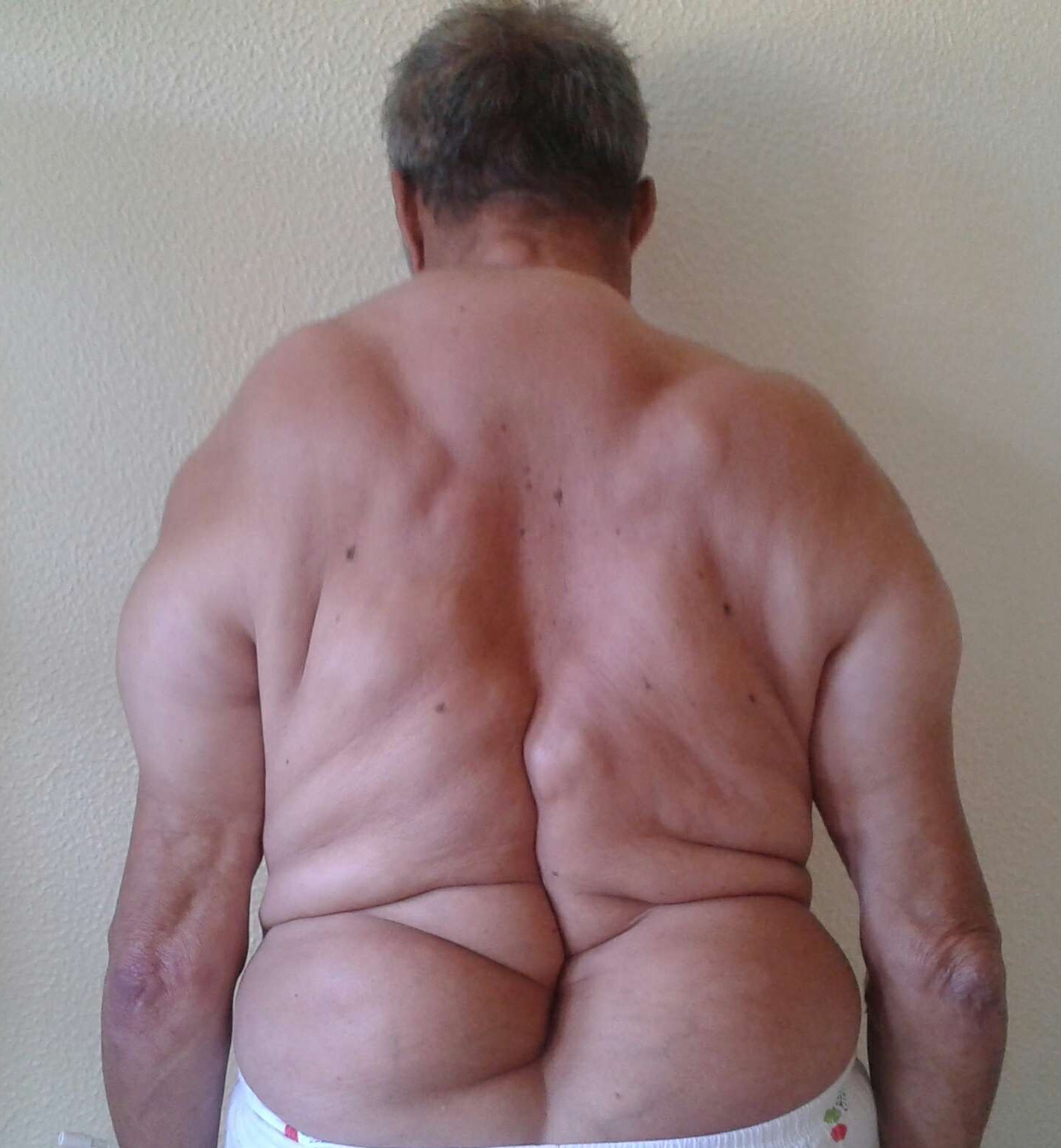Introduction: Multiple symmetric lipomatosis (MSL) is a rare condition, characterized by a symmetrical accumulation of non-encapsulated adipose tissue, usually localized in the cervical region and upper body.1,2The etiology is unknown, but has been described an association with high ethanol intake in about 90% of the patients3. MSL has its highest incidence in the Mediterranean region.2,4,
Case presentation: The authors present the case of a 72-year-old male, with history of heavy alcohol consumption and no chronic prescribed medication. Ten days prior to admission, the patient was medicated with Amoxicilin and clavulanic acid and Aceclofenac for a dental abscess, with complete remission. One week later, presented with generalized muscular weakness, predominant in the lower limbs, and asthenia. He was admitted to the Internal Medicine Department with acute toxic hepatitis (ALT 564U/L, AST 2354U/L) due to excessive intake of nonsteroidal anti-inflammatory drugs, associated with severe rhabdomyolysis (creatine phosphokinase (CPK) 25.129U/L), acute renal failure (Creatinine 2,12mg/dL, RIFLE R) and hyperkaliemia (6,00mmol/L).
At admission, the patient weighed 93kg, with a body mass index of 30,37kg/m2. Physical examination showed multiple large lipomas, symmetrically distributed in upper and lower back, shoulders, arms and abdominal wall, sparing the neck (figures 1, 2 and 3). In the abdominal wall, most of the lipomas had an average side of 15cm, with a maximum diameter of 23cm. The biggest lipoma was in the upper back, with 30cm of larger diameter. On the lower back, the patient present two large lipomas, with 20cm of diameter.
During hospitalization, the patient maintained intensive fluid therapy and eviction of hepatotoxic and nephrotoxic drugs, presenting full recovery at the time of discharge. The patient wasn’t proposed for surgical treatment of the lipomatosis by own option. Maintenance of alcoholic avoidance and suspension of non-steroidal anti-inflammatory drugs were recommended.
Discussion: MSL is characterized by symmetric, diffuse, painless, non-encapsulated and irreversible growth of lipomas.1 As said, the etiology of this disease is unknow. However, there is new evidence of influence of mitochondrial disorder of brown fat tissue, or a defect in adrenergic stimulated lipolysis.1,5 The alcohol impact on fat storage and development of lipomas seems to be related to changes it induces in β-adrenergic receptors as a cofactor, hampering β-oxidation and promoting liponeogenesis.6
Madelung’s disease phenotype is variable, however in the more classical presentation there is involvement of the face, neck, occipital fossa and shoulder areas. Lipomatosis around the neck is known as “buffalo hump” or “horse collar”, and fat deposits on the parotid region may appear as “hamster cheek”1.
This case shows an atypical and unusual distribution of lipomatosis, with large fat deposits all over the trunk, shoulders and upper arms, without the classic neck involvement.
It also represents a possible relation between lipomatosis and the degree of severity of the rhabdomyolysis presented, which cannot be ignored by the high risk of developing acute renal injury. The large number and size of the lipomas was admitted as the main cause of the high value of CPK presented, with an identified triggering factor. If untreated, this severe rhabdomyolysis, could have resulted in critical and potentially irreversible renal failure. Surgical treatment is the only effective solution, being alcohol withdrawal crucial to delay the disease progression.
Figura I

Physical examination - anterior view.
Figura II

Physical examination - posterior view.
Figura III

Physical examination - right lateral view.
BIBLIOGRAFIA
1. Mimica M, Pravdic D, Nakas-Icindic E, Karin M, Babic E, Tomic M, Bevanda M. Multiple Symmetric Lipomatosis: A Diagnostic Dilemma, Case Reports in Medicine, Volume 2013 (2013), Article ID 836903
2. Enzi G, Busetto L, Ceschin E, Coin A, Digito M, Pigozzo S. Multiple symmetric lipomatosis: clinical aspects and outcome in a long-term longitudinal study. Int J Obes Relat Metab Disord. 2002 Feb;26(2):253-61.
3. Ko MJ, Chiu HC, “Madelung’s disease and alcoholic liver disorder”, Hepatology, vol. 51, no. 4, pp. 1466-1467, 2010
4. Carvalho M, Palma P, Silva F, Patacho M, Coelho F. Multiple Symmetrical Lipomatosis: Madelung’s Disease, J Med Cases. 2016;7(5):178-180
5. Plummer C, Spring PJ, Marotta R, Chin J, Taylor G, Sahrpe D, Athanasou NA, et al. Multiple Symmetrical Lipomatosis – a mitochondrial disorder of brown fat. Mitochondrion. 2013;13(4):269-276
6. Iglesias L, Perez-Llantada E, Saro G, Pino M, Hernandez JL. Benign symmetric lipomatosis (Madelung’s disease). European Journal of Internal Medicine, 11(3), 171–173




